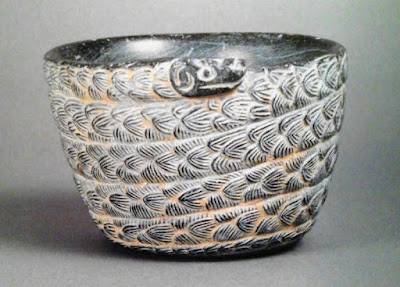Inspecting the damage the next day, local residents discovered that a cache of valuable ancient artifacts had washed out and been scattered along the river's bank. They immediately snatched them up to sell, but the police got wind of it, too, and raided the houses of people who had been picking up artifacts or offering them for sale. I can't find any clear statement of the timeline here, but so far as I can tell months might have passed between the first discoveries and the first police seizures.
When some archaeologists finally arrived they were startled by the quality of the finds; what were these marvelous Bronze Age artifacts doing in Jiroft, a city with no archaeological record?
Exploring the two mounds, which are more than three kilometers apart, the archaeologists realized that they contained the remains of a Bronze Age city. Feeling over their heads, they called in Jean Perrot, a leading French archaeologist who had for years directed excavations at the ancient site of Susa. Perrot confirmed that this was indeed a Bronze Age city and he suggested that it might be a site of the highest importance.
All of the object shown here were carved from a soft stone called chlorite, in a style well known to archaeologists and collectors. Similar works are known from Sumer, Elam, and the oasis cities of Bacrtria, dating to between 2700 and 1700 BC. They look just about the same across this whole area, and nobody can agree on where the style originated; some say Elam, some say the Iranian Plateau, while others think they were made across this whole region and are therefore evidence of widespread cultural sharing. When Jean Perrot found them in profusion at Jiroft, he suggested that the origin point of this style had been found.
Beginning in 2003 Iranian archaeologists under the direction of Yousef Majidzadeh carried out a substantial excavation at the site, exploring large areas of the mounds. One of them turned out to contain a citadel measuring 33 acres (13.5 hectares). The site seems to have reached its peak between 2500 and 2200 BC. Majidzadeh thinks that the Jiroft mounds were the capital of a kingdom the Sumerians called Aratta, from which, tablets say, they imported valuable objects.
The most impressive find was a ziggurat, its shape related to those is Sumer but not identical.
Love this sinister reconstruction.
So Jiroft is an exciting discovery, a real Bronze Age city, a possible link between Elam and Bactria.
And that is where agreement about it ends. First, there are a lot of questions about the initial artifact bonanza. Quite a few more chlorite vessels have been found during the excavations, but nothing like the incredible haul generated by that first flood. This has led some skeptics to speculate that what the police seized had actually been collected across the region over a period of years, I mean, if you wanted to sell an ancient chlorite vessel, wouldn't you take it to a known dealer in such objects?
And such dealers might also trade in fakes. Chlorite vessels have been valuable antiquities for a century, and it is well known among collectors that many specimens on the market are modern. I especially wonder about this falcon. I found it posted with a caption saying that it represents great cultural continuity in Iran, since it looks just like Sassanian falcons from 2,000 years later. I think it more likely represents a forger with a weak grasp of periodization in history.
There are also a lot of questions about these tablets. The writing seems related to Elamite but is not identical to it and reading some of this on the assumption that it is Elamite produced gibberish. Nor has anyone been able to produce a standard set of symbols or the like for these, leading some to argue that at least some of them must be fake.
But as I said more chlorite vessels were found in good contexts during the excavation, so the people of Jiroft certainly used them, which gives us an excuse to spend a while with these wonderful objects.
And to dream about finding lost civilizations, or digging up the treasures of cities mentioned in Cuneiform tablets but never before discovered, or translating unknown scripts and finding the names of forgotten peoples and their vanished gods. And other marvelous things.


















2 comments:
while others think they were made across this whole area and are therefore evidence of widespread cultural sharing
Much like how for centuries everyone stretching from Morocco, to the Kievan 'Rus, to the Indian subcontinent employed arms and armor that were effectively interchangeable?
Everybody had their own variation of the cataphract - equipped with functionally identical sabres, round shields, spears, and composite bows suited to use on horseback; clad in mail and lamellar armor of remarkable uniformity of design, with some version or another of the spangenhelm and nasal helmet, often with a mail coif or face mask. Local styles and decorations vary, but the equipment and its usage remained staggeringly consistent across many different cultures for hundreds of years.
People copy each other. Not always, but frequently - especially in matters of production techniques and designs for practical physical objects made en masse.
I just want to add a quick thank you for all your excellent posts. They are really a highlight of my inbox each morning.
Post a Comment